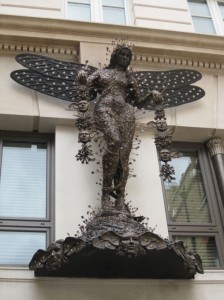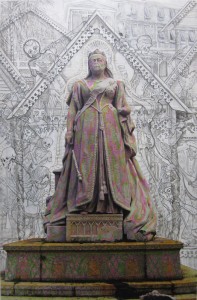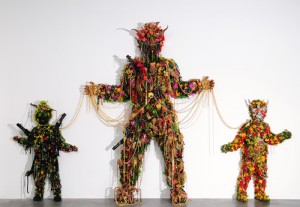
Born in Edinburgh, UK, and raised as a child in Guyana, to a Guyanese sculptor father, Donald Locke, and an English painter mother, Hew Locke has art and multiculturalism running right through him. His work is vibrant, challenging and a real wonder to behold.
Locke was born in 1959, lived from 1966 to 1980 in Guyana and is currently based in London. He obtained a B.A. Fine Art in Falmouth (1988) and an M.A. Sculpture at the Royal College of Art, London (1994). In 2000 he won both a Paul Hamlyn Award and an East International Award.
His work is represented in many notable collections including The Government Art Collection, The Tate Gallery collection, The Arts Council of England collection, The Collection of Eileen and Peter Norton, Santa Monica, The Brooklyn Museum collection, New York, The Arnold Lehman collection, The Kemper Museum of Contemporary Art, Kansas City collection, The RSID Museum, Rhode Island, The New Art Gallery Walsall, The Victoria & Albert Museum Drawing Collection, London, The British Museum, London and The Henry Moore Institute, Leeds.

Locke shot to international prominence in 2000 when he was awarded both a Paul Hamlyn Award and the EAST International Award. The same year he created the installation “Hemmed in Two” for the Victoria & Albert Museum. Still one of his most famous works, this sculpture – a fusion of ideas and materials symbolising all at once a boat, a city, an animal, and a bacterial virus – was one of the most prominent to have been made by a multicultural British artist at the time.
Part boat, part package, part city, part animal, part infestation, “Hemmed in Two” demonstrates the beauty of failure. It is made out of a material that is very useful, an everyday material, and a perishable material.
It is a reflection on the global “commodification” of culture and its history, while the barcodes acknowledge that this piece is itself a commodity which can become cargo or freight as soon as it leaves the studio. At once shambolic and magnificent, with references to baroque, medieval and Islamic architecture, “Hemmed in Two” grew organically in the way of Kurt Schwitter’s “Merz Barn”. The piece is re-configured for each venue.
Literally built onto an original piece titled “Hemmed In” (1999), “Hemmed In Two” was developed as an intervention into the fabric of the Victoria and Albert Museum, and references the museums’ collection and problematic history. “Hemmed in Two” incorporates a piece called “Merchandise”, which itself incorporates a figure from “Raft”.
The artist does not have a preferred medium, instead utilising any that supports the message that he is trying to impart. A trained sculptor, he is similarly skilled in painting, drawing, photography, relief, fabric, casting and collage. This work, “I Have Found a Song”, is a book made by Locke in collaboration with Chris Steele-Perkins, Paula Rego, Shanti Panchal and Sonia Boyce.

His inspiration is drawn from a wide range of sources including baroque, rococo, Hindu, Islamic and colonial architecture along with fairground and carnival art and cumfa, a local form of voodoo in British Guiana where he grew up.
One of his most recent pieces, ‘Selene’, is a permanent artwork in Carlisle Street, Soho, London, commissioned by the Nadler Soho Hotel.
“Selene is named for the Greek goddess of the moon and of magic. I was commissioned to create a sculpture representing ‘Sleep’. I wanted to make a classical statue with a contemporary twist, and was keen to create a statue of a black woman, rare in London. The statue is informed by Art Nouveau, Victorian fairy paintings (especially those of Atkinson Grimshaw), and by the sight of a group of tall, glamorous drag queens parading down the road in Soho at three o’clock one afternoon. She is a powerful goddess reworked for today’s London – a dream-weaver and magical protector.
“Selene floats at the centre of a galaxy of stars, offering garlands representing magical potions associated with sleep and love. Referencing Theatre land, I have included belladonna (a plant proposed as being that creating Juliet’s deep-sleep in ‘Romeo and Juliet’) and pansies (used as a love potion in “A Midsummer’s Night’s Dream”). Two different night-blooming flowers known as ‘Queen of the Night’ – one a type of cactus, the other a type of jasmine – are joined by winged masks of the Greek personification of sleep, Hypnos. She also holds night-blooming dragon fruit flowers, this particular variety is named the ‘David Bowie’, and references Ziggy Stardust’s associations with Soho.” he explained on his website.
As an artist with a diverse cultural background, multiculturalism is a recurrent theme in his work. His imagery is punctuated throughout with visual expressions of globalisation, movement of peoples, ships and boats, colonialism, power and trophies.

In recent years, Locke has focused on his fascination and ambivalence around ideas and images of “Britishness” in a global context, such as the royal family. Locke explores global cultural fusions, creating complex sculptural collages with an eclectic range of objects, including mass produced toys, souvenirs and consumer detritus. (Excerpted from www.artfinder.com, www.hewlocke.net)



